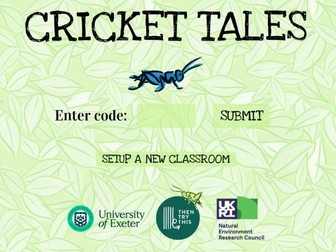Cricket Tales - graphs, variation, natural selection, hypotheses, careers
<p>Our aim is to provide a resource that allows teachers to bring research into the classroom addressing key points in the curriculum using an interactive data collection game based on video from a real research project. The lesson is robust to some students failing to engage and avoids situations where some students are waiting for others to finish.</p>
<p>Cricket Tales is real research project run by Scientist Tom Tregenza and his team at the University of Exeter. The project studies a natural population of crickets in a meadow using a network of 140 video cameras that monitor each individual cricket 24/7. This is the first long-term study of the behaviour of wild insects, and is designed to study questions including about how flexible insects are in their behaviour and how they may be able to cope as our climate changes.</p>
<p>You can run the whole lesson or take elements to supplement teaching.</p>
<p>This is a great resource to meet Gatsby Benchmark 4 to show strong links between careers and classroom learning, and is most suitable for years 6 to 9 - at KS3 there are good curriculum links.</p>
<p>Suggested links to the National Curriculum<br />
• Continuous and discontinuous variation - the variation between individuals within a species being continuous or discontinuous, to include measurement and graphical representation of variation<br />
• Natural selection: the variation between individuals can mean that some compete more successfully, when they have more offspring this is natural selection<br />
• Interpretation of a graph: interpret observations and data, including identifying patterns and using observations, measurements and data to draw conclusions<br />
• Ask questions and develop a line of enquiry based on observations of the real world, alongside prior knowledge and experience.<br />
• Present reasoned explanations, including explaining data in relation to predictions and hypotheses</p>
<p>These resources were produced as a collaboration between Prof. Tom Tregenza, Janine Bisson and Then Try This, and the work was funded by the Natural Environment Research Council.</p>
